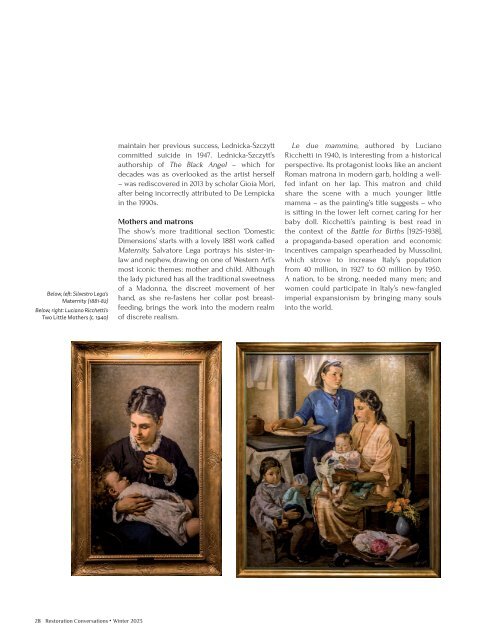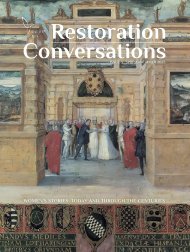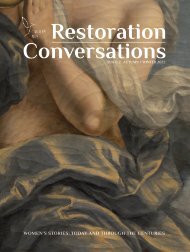Winter 2023
Restoration Conversations is a digital magazine spotlighting the achievements of women in history and today. We produce two issues a year: Spring/Summer and Fall/Winter
Restoration Conversations is a digital magazine spotlighting the achievements of women in history and today. We produce two issues a year: Spring/Summer and Fall/Winter
You also want an ePaper? Increase the reach of your titles
YUMPU automatically turns print PDFs into web optimized ePapers that Google loves.
Below, left: Silvestro Lega’s<br />
Maternity (1881-82)<br />
Below, right: Luciano Ricchetti’s<br />
Two Little Mothers (c. 1940)<br />
maintain her previous success, Lednicka-Szczytt<br />
committed suicide in 1947. Lednicka-Szczytt’s<br />
authorship of The Black Angel – which for<br />
decades was as overlooked as the artist herself<br />
– was rediscovered in 2013 by scholar Gioia Mori,<br />
after being incorrectly attributed to De Lempicka<br />
in the 1990s.<br />
Mothers and matrons<br />
The show’s more traditional section ‘Domestic<br />
Dimensions’ starts with a lovely 1881 work called<br />
Maternity. Salvatore Lega portrays his sister-inlaw<br />
and nephew, drawing on one of Western Art’s<br />
most iconic themes: mother and child. Although<br />
the lady pictured has all the traditional sweetness<br />
of a Madonna, the discreet movement of her<br />
hand, as she re-fastens her collar post breastfeeding,<br />
brings the work into the modern realm<br />
of discrete realism.<br />
Le due mammine, authored by Luciano<br />
Ricchetti in 1940, is interesting from a historical<br />
perspective. Its protagonist looks like an ancient<br />
Roman matrona in modern garb, holding a wellfed<br />
infant on her lap. This matron and child<br />
share the scene with a much younger little<br />
mamma – as the painting’s title suggests – who<br />
is sitting in the lower left corner, caring for her<br />
baby doll. Ricchetti’s painting is best read in<br />
the context of the Battle for Births [1925-1938],<br />
a propaganda-based operation and economic<br />
incentives campaign spearheaded by Mussolini,<br />
which strove to increase Italy’s population<br />
from 40 million, in 1927 to 60 million by 1950.<br />
A nation, to be strong, needed many men; and<br />
women could participate in Italy’s new-fangled<br />
imperial expansionism by bringing many souls<br />
into the world.<br />
28 Restoration Conversations • <strong>Winter</strong> <strong>2023</strong>





